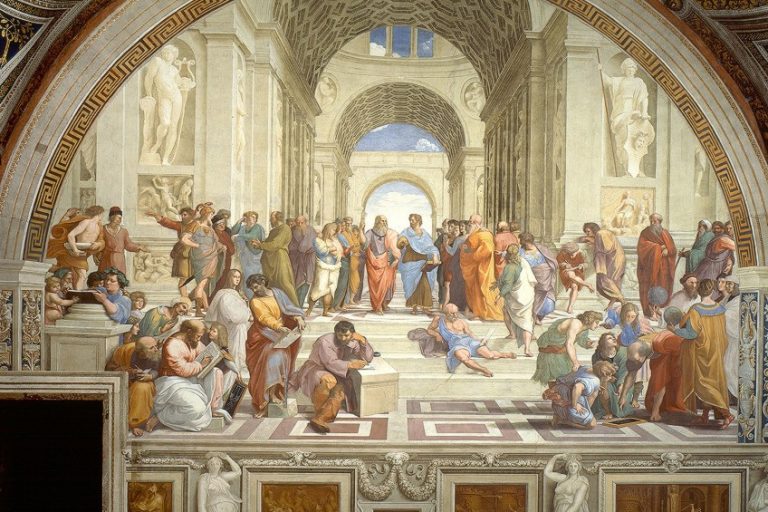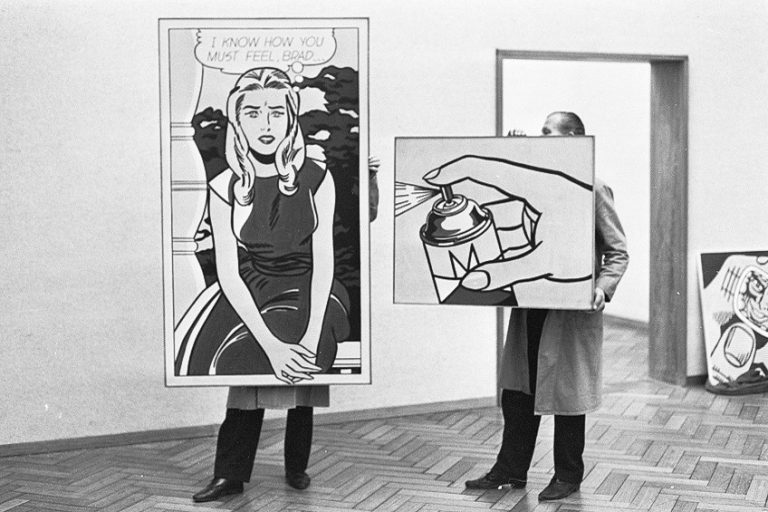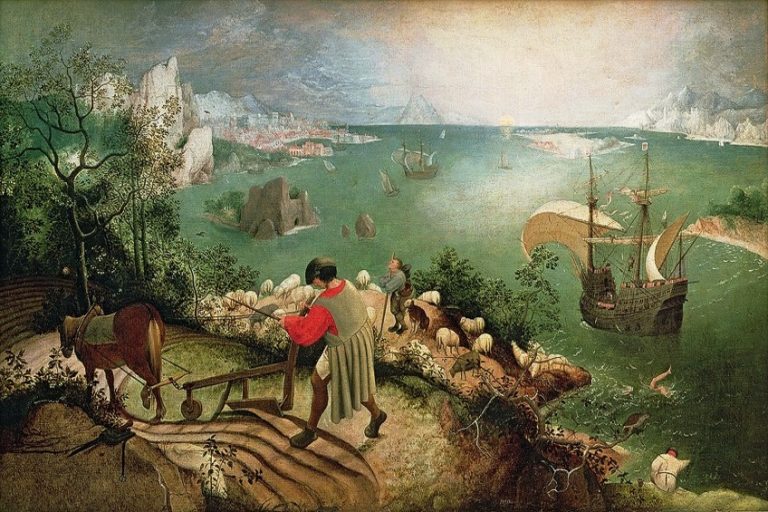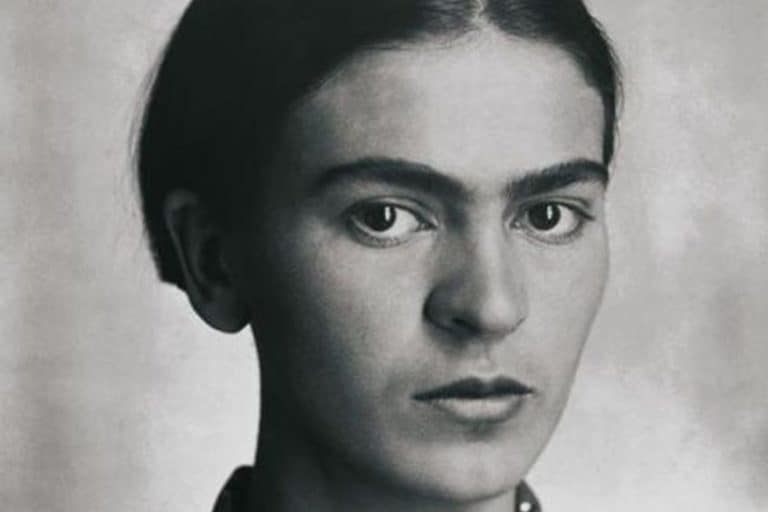Vincent van Gogh Paintings – The Best Works by the Great Painter
Vincent van Gogh, the enigmatic luminary of Post-Impressionism, forged an unparalleled legacy through his tumultuous life and extraordinary artistic output. In this exploration, we delve into the top 20 paintings that epitomize his genius, from the sun-drenched landscapes of southern France to the intimate portrayals of everyday life. Through bold colors, swirling brushstrokes, and profound emotional depth, Van Gogh’s masterpieces continue to captivate audiences, inviting us to contemplate the beauty and complexity of existence in all its myriad forms.
Table of Contents
- 1 Top 20 Paintings by Vincent van Gogh
- 1.1 The Potato Eaters (1885)
- 1.2 Self-Portrait with Straw Hat (1887)
- 1.3 Sunflowers (1887)
- 1.4 Still Life: Vase with Twelve Sunflowers (1888)
- 1.5 The Red Vineyard (1888)
- 1.6 The Bedroom (1888)
- 1.7 Starry Night Over the Rhône (1888)
- 1.8 Café Terrace at Night (1888)
- 1.9 The Night Café (1888)
- 1.10 Self-Portrait with Bandaged Ear (1889)
- 1.11 Self-Portrait (1889)
- 1.12 The Starry Night (1889)
- 1.13 Portrait of Joseph Roulin (1889)
- 1.14 The Olive Trees (1889)
- 1.15 Irises (1889)
- 1.16 Wheatfield with Crows (1890)
- 1.17 Portrait of Dr. Gachet (1890)
- 1.18 Almond Blossoms (1890)
- 1.19 Field with Poppies (1890)
- 1.20 The Church at Auvers (1890)
- 2 Frequently Asked Questions
Top 20 Paintings by Vincent van Gogh
Vincent van Gogh, a revolutionary Dutch Post-Impressionist artist, is celebrated for his dynamic brushwork and emotive portrayals of the world around him. His body of work is vast and subjective to select from, given his prolific output and diverse styles. Nevertheless, we have curated a selection of 20 iconic paintings by Van Gogh, each a testament to his unparalleled vision and artistic brilliance, for you to explore below!

The Potato Eaters (1885)
| Date | 1885 |
| Medium | Oil on canvas |
| Dimensions (cm) | 82 × 114 |
| Where Is It Housed? | Van Gogh Museum, Amsterdam, Netherlands |
The painting, The Potato Eaters, portrays a collection of rural laborers congregated around a modest table, lit by only one lamp. Van Gogh’s use of dark, earthy tones and thick, expressive brushstrokes conveys the gritty reality of rural life. The worn visages and calloused hands of the characters convey the trials faced by the laboring populace.
Through this somber scene, Van Gogh aimed to capture the dignity and resilience of the peasants.

Self-Portrait with Straw Hat (1887)
| Date | 1887 |
| Medium | Oil on canvas |
| Dimensions (cm) | 41.3 × 32.1 |
| Where Is It Housed? | Detroit Institute of Arts, Detroit, Michigan, United States |
In Self-Portrait with Straw Hat, Van Gogh presents himself with intensity and introspection. The bold, confident brushstrokes and vivid colors convey a sense of vitality and self-assurance. Van Gogh’s piercing gaze and furrowed brow hint at the inner turmoil and creative fervor that characterized his life and work.
Through this self-portrait, Van Gogh invites viewers to glimpse into the depths of his psyche and artistic vision.

Sunflowers (1887)
| Date | 1887 |
| Medium | Oil on canvas |
| Dimensions (cm) | 92.1 × 73 |
| Where Is It Housed? | National Gallery, London, United Kingdom |
Sunflowers epitomizes Van Gogh’s fascination with color, texture, and nature’s beauty. The lively colors and energetic strokes of the brush imbue the composition with a feeling of motion and vitality. Van Gogh’s meticulous attention to detail, particularly in the depiction of the sunflowers’ petals and stems, reflects his reverence for the natural world.
This series of paintings serves as a celebration of life and a testament to Van Gogh’s unparalleled mastery of color and form.
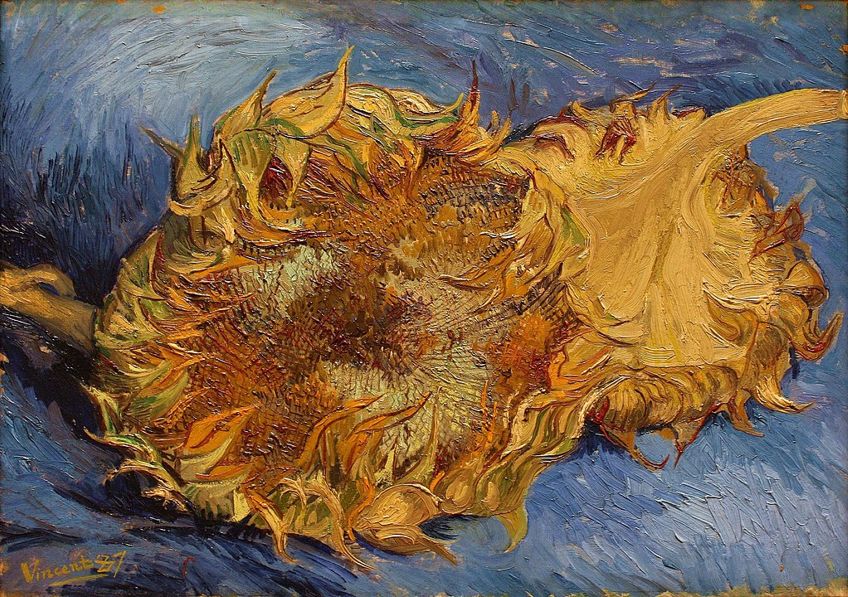
Still Life: Vase with Twelve Sunflowers (1888)
| Date | 1888 |
| Medium | Oil on canvas |
| Dimensions (cm) | 91 × 72 |
| Where Is It Housed? | Neue Pinakothek, Munich, Germany |
In Still Life: Vase with Twelve Sunflowers, Van Gogh transforms a simple arrangement of sunflowers into a symphony of color and light. The contrasting hues of yellow and blue create a harmonious visual balance, while the thick impasto technique adds depth and texture to the composition. Van Gogh’s fascination with the play of light and shadow is evident in the way he captures the delicate petals and sturdy stems of the sunflowers.
This artwork serves as a vivid testament to Van Gogh’s skill in imbuing ordinary subjects with profound beauty.

The Red Vineyard (1888)
| Date | 1888 |
| Medium | Oil on canvas |
| Dimensions (cm) | 75 × 93 |
| Where Is It Housed? | Pushkin Museum of Fine Arts, Moscow, Russia |
The Red Vineyard captures the lush beauty of the French countryside with vibrant hues and bold brushwork. Van Gogh’s use of contrasting colors and dynamic composition infuses the scene with a sense of vitality and movement. The swirling patterns in the sky and the rhythmic lines of the vineyard convey a palpable sense of energy and emotion.
As one of the few paintings Van Gogh sold during his lifetime, The Red Vineyard holds a special place in the artist’s oeuvre and serves as a testament to his enduring legacy.

The Bedroom (1888)
| Date | 1888 |
| Medium | Oil on canvas |
| Dimensions (cm) | 72.4 × 91.3 |
| Where Is It Housed? | Van Gogh Museum, Amsterdam, Netherlands |
The Bedroom offers a glimpse into Van Gogh’s personal sanctuary and his profound connection to his surroundings. The simple yet evocative depiction of the artist’s bedroom conveys a sense of intimacy and tranquility.
Van Gogh’s use of bold, flat colors and simplified forms lends the painting a sense of emotional depth and psychological insight.

Starry Night Over the Rhône (1888)
| Date | 1888 |
| Medium | Oil on canvas |
| Dimensions (cm) | 72.5 × 92 |
| Where Is It Housed? | Musée d’Orsay, Paris, France |
Starry Night Over the Rhône captures the ethereal beauty of the night sky with mesmerizing intensity. The swirling strokes of Van Gogh’s brush and his vivid color palette express a feeling of motion and liveliness within the painting.
The contrast between the serene river and the swirling sky evokes a feeling of cosmic balance and awe.

Café Terrace at Night (1888)
| Date | 1888 |
| Medium | Oil on canvas |
| Dimensions (cm) | 81 × 65.5 |
| Where Is It Housed? | Kröller-Müller Museum, Otterlo, Netherlands |
In Café Terrace at Night, Van Gogh infuses a mundane scene with a sense of magic and mystery. The warm, inviting glow of the café’s interior contrasts with the cool, starry sky above.
Van Gogh’s use of vibrant colors and bold brushwork creates a sense of energy and vitality within the composition.

The Night Café (1888)
| Date | 1888 |
| Medium | Oil on canvas |
| Dimensions (cm) | 72.4 × 92.1 |
| Where Is It Housed? | Yale University Art Gallery, New Haven, Connecticut, United States |
The Night Café exudes an eerie, otherworldly atmosphere with its intense colors and distorted perspective. Van Gogh’s use of vibrant reds and greens creates a sense of claustrophobia and unease within the composition.
The harsh, angular lines and stark contrasts between light and shadow heighten the sense of tension and foreboding.
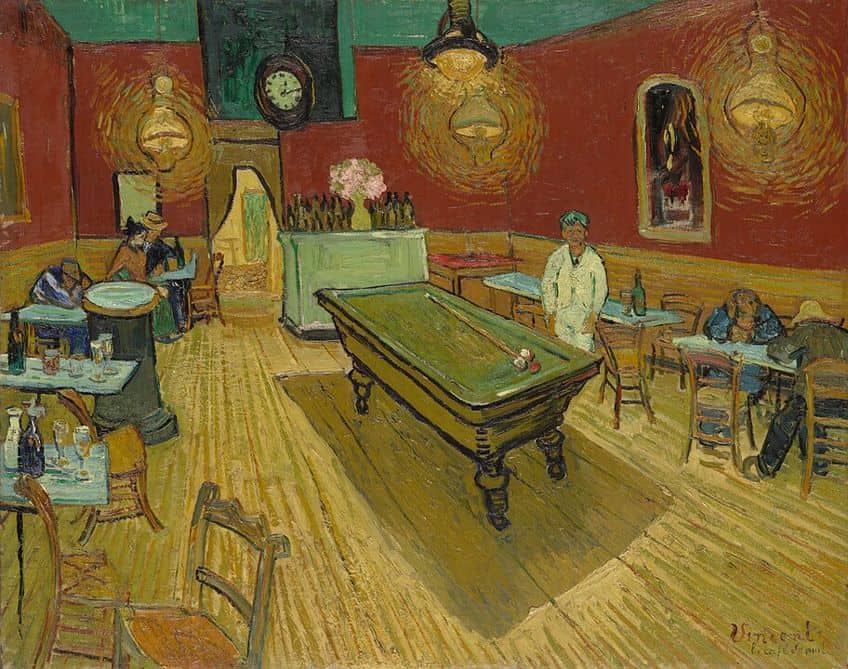
Self-Portrait with Bandaged Ear (1889)
| Date | 1889 |
| Medium | Oil on canvas |
| Dimensions (cm) | 60 × 49 |
| Where Is It Housed? | Courtauld Gallery, London, United Kingdom |
In Self-Portrait with Bandaged Ear, Van Gogh confronts his own suffering and vulnerability with unflinching honesty. The bandaged ear serves as a poignant reminder of the artist’s mental and emotional anguish.
Van Gogh’s piercing stare and creased forehead reveal a depth of introspection and internal conflict.

Self-Portrait (1889)
| Date | 1889 |
| Medium | Oil on canvas |
| Dimensions (cm) | 65 × 54 |
| Where Is It Housed? | National Gallery of Art, Washington D.C., United States |
In Self-Portrait, Van Gogh presents himself with a sense of dignity and resilience amidst personal turmoil. The assertive, assured brushwork and penetrating stare mirror the artist’s steadfast dedication to his artistry.
Van Gogh’s use of vibrant colors and dynamic composition imbues the portrait with a sense of vitality and strength.

The Starry Night (1889)
| Date | 1889 |
| Medium | Oil on canvas |
| Dimensions (cm) | 73.7 × 92.1 |
| Where Is It Housed? | Museum of Modern Art, New York City, United States |
The Starry Night stands as a pinnacle of van Gogh’s artistic achievement, capturing the ineffable beauty of the night sky with breathtaking intensity. The swirling designs and lively hues evoke a feeling of cosmic amazement and reverence.
Van Gogh’s employment of bold, expressive strokes injects the scene with a sense of motion and vitality.

Portrait of Joseph Roulin (1889)
| Date | 1889 |
| Medium | Oil on canvas |
| Dimensions (cm) | 64.4 × 55.2 |
| Where Is It Housed? | Museum of Modern Art, New York City, United States |
Portrait of Joseph Roulin showcases Van Gogh’s ability to capture the essence of his subjects with empathy and insight. The rich, natural hues and emotive brushstrokes communicate a feeling of closeness and warmth.
Roulin’s dignified expression and thoughtful gaze speak to the depth of his character and the bond between artist and sitter.

The Olive Trees (1889)
| Date | 1889 |
| Medium | Oil on canvas |
| Dimensions (cm) | 72 × 90 |
| Where Is It Housed? | The Nelson-Atkins Museum of Art, Missouri, United States |
In The Olive Trees, Van Gogh transforms a simple landscape into a vibrant tapestry of color and texture. The twisting designs of the olive trees and the radiant shades of the sky instill a feeling of liveliness and vigor in the painting.
Van Gogh’s utilization of daring, emotive brushstrokes saturates the scene with an essence of vigor and sentiment.
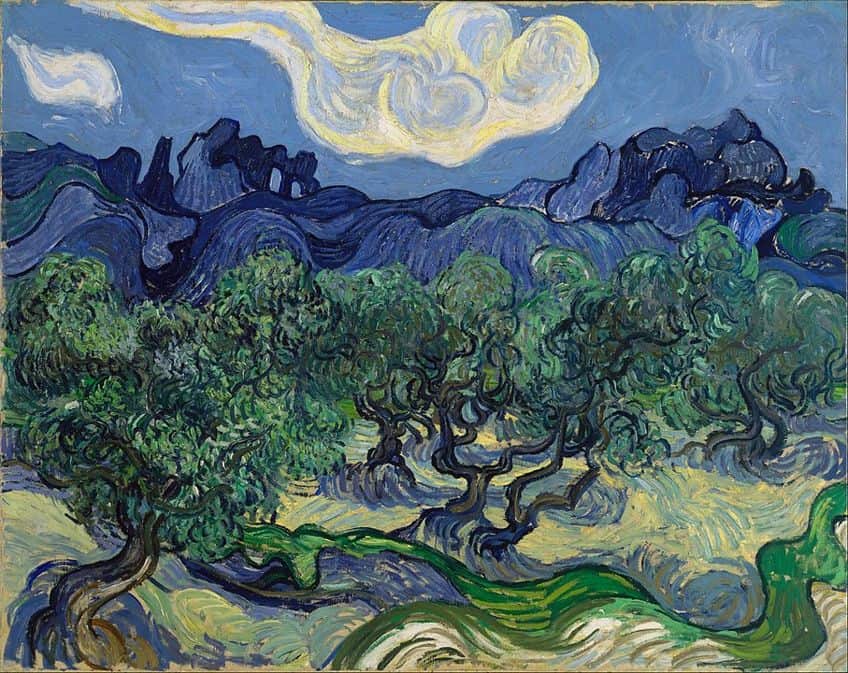
Irises (1889)
| Date | 1889 |
| Medium | Oil on canvas |
| Dimensions (cm) | 74.3 × 94.3 |
| Where Is It Housed? | J. Paul Getty Museum, Los Angeles, United States |
Irises showcases Van Gogh’s mastery of color and form, capturing the delicate beauty of the flowers with exquisite detail. The vivid colors and energetic brushstrokes generate a feeling of motion and liveliness in the artwork.
Van Gogh’s use of contrasting colors and bold, expressive lines imbues the painting with a sense of energy and emotion.

Wheatfield with Crows (1890)
| Date | 1890 |
| Medium | Oil on canvas |
| Dimensions (cm) | 50.5 × 103 |
| Where Is It Housed? | Van Gogh Museum, Amsterdam, Netherlands |
In Wheatfield with Crows, Van Gogh confronts themes of mortality and transcendence with haunting intensity. The swirling motifs of the wheatfield and the dramatic sky evoke a feeling of unrest and uncertainty within the painting.
The ominous inclusion of the crows contributes to an atmosphere of impending danger and intrigue in the scene.

Portrait of Dr. Gachet (1890)
| Date | 1890 |
| Medium | Oil on canvas |
| Dimensions (cm) | 67 × 56 |
| Where Is It Housed? | Musée d’Orsay, Paris, France |
Portrait of Dr. Gachet captures the melancholy beauty of Van Gogh’s final days with poignant intensity. The sensitive portrayal of Dr. Gachet’s weary expression and soulful eyes conveys a sense of empathy and understanding.
Van Gogh’s use of muted colors and subtle brushwork adds to the painting’s sense of emotional depth and intimacy.
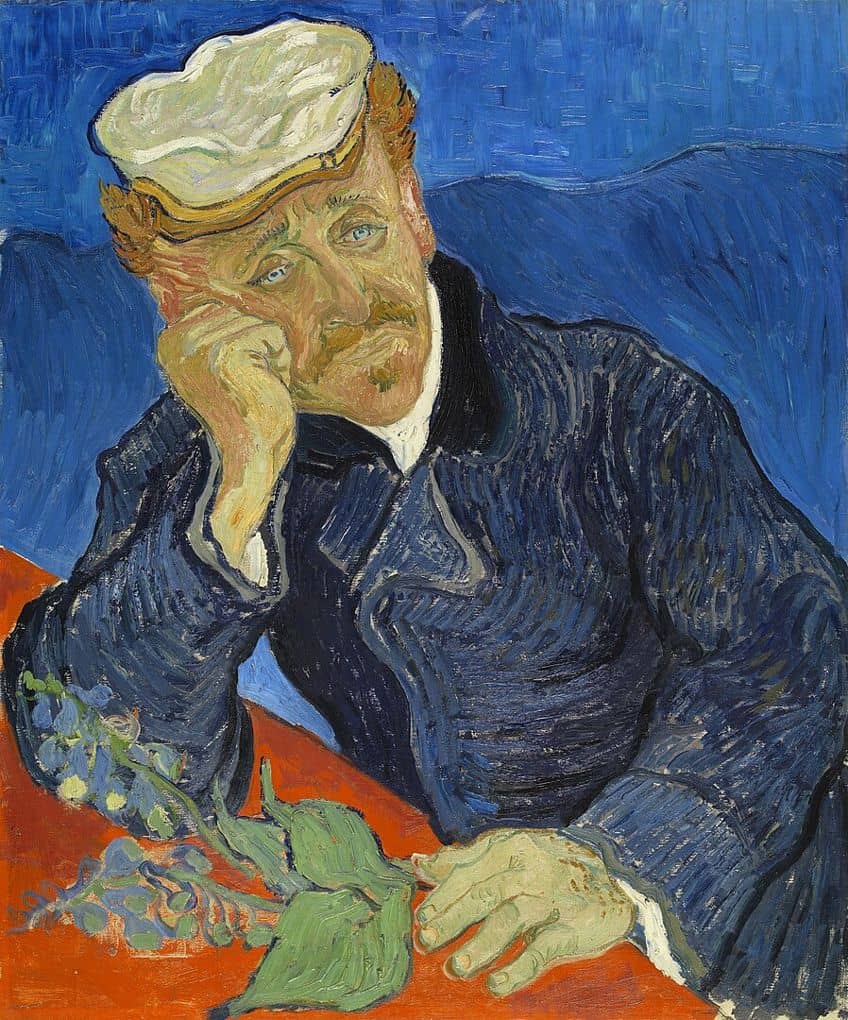
Almond Blossoms (1890)
| Date | 1890 |
| Medium | Oil on canvas |
| Dimensions (cm) | 73.3 × 92.4 |
| Where Is It Housed? | Van Gogh Museum, Amsterdam, Netherlands |
Almond Blossoms exudes a sense of serenity and renewal with its delicate depiction of flowering branches against a vibrant blue sky. Van Gogh’s use of bold, expressive brushwork and luminous colors captures the ephemeral beauty of the blossoms with breathtaking intensity.
The rhythmic patterns and dynamic composition imbue the painting with a sense of movement and vitality.

Field with Poppies (1890)
| Date | 1890 |
| Medium | Oil on canvas |
| Dimensions (cm) | 73 × 91 |
| Where Is It Housed? | Gemeentemuseum Den Haag, the Hague, Netherlands |
Field with Poppies captures the vibrant colors and dynamic energy of the French countryside with breathtaking intensity. Van Gogh’s employment of daring, expressive brushstrokes and vibrant colors instills a feeling of motion and liveliness in the artwork.
The rhythmic patterns and dynamic composition imbue the painting with a sense of joy and exuberance.

The Church at Auvers (1890)
| Date | 1890 |
| Medium | Oil on canvas |
| Dimensions (cm) | 94 × 74 |
| Where Is It Housed? | Musée d’Orsay, Paris, France |
The Church at Auvers encapsulates the serene charm of the French countryside with captivating depth. Van Gogh’s bold, emotive brushwork and lively colors imbue the composition with a feeling of dynamism and liveliness. The rhythmic patterns and dynamic composition imbue the painting with a sense of serenity and spiritual resonance.

Vincent van Gogh’s top 20 paintings encapsulate his unparalleled creativity and deep understanding of humanity. From the swirling stars of The Starry Night to the vibrant fields of Wheatfield with Crows, each masterpiece reflects his bold use of color and emotive brushwork. Van Gogh’s enduring legacy as one of history’s greatest artists is undeniable, with his works continuing to inspire and captivate audiences worldwide with their timeless beauty and profound emotional depth.
Frequently Asked Questions
Why Are Vincent van Gogh’s Paintings So Popular?
Vincent van Gogh’s paintings are popular for their unique style, bold colors, and dynamic brushwork, captivating viewers and evoking strong emotions. His tumultuous life story and universal themes of nature and humanity add layers of intrigue and resonance, making his works enduringly popular across cultures and generations.
How Many Artworks Did Vincent van Gogh Create During His Lifetime?
Vincent van Gogh created around 2,100 artworks during his lifetime. These comprised paintings, drawings, and sketches. The extensive body of his work mirrors his steadfast commitment to his artistry and his relentless quest for creative expression spanning numerous subjects and artistic approaches.
Isabella studied at the University of Cape Town in South Africa and graduated with a Bachelor of Arts majoring in English Literature & Language and Psychology. Throughout her undergraduate years, she took Art History as an additional subject and absolutely loved it. Building on from her art history knowledge that began in high school, art has always been a particular area of fascination for her. From learning about artworks previously unknown to her, or sharpening her existing understanding of specific works, the ability to continue learning within this interesting sphere excites her greatly.
Her focal points of interest in art history encompass profiling specific artists and art movements, as it is these areas where she is able to really dig deep into the rich narrative of the art world. Additionally, she particularly enjoys exploring the different artistic styles of the 20th century, as well as the important impact that female artists have had on the development of art history.
Learn more about Isabella Meyer and the Art in Context Team.
Cite this Article
Isabella, Meyer, “Vincent van Gogh Paintings – The Best Works by the Great Painter.” Art in Context. February 12, 2024. URL: https://artincontext.org/vincent-van-gogh-paintings/
Meyer, I. (2024, 12 February). Vincent van Gogh Paintings – The Best Works by the Great Painter. Art in Context. https://artincontext.org/vincent-van-gogh-paintings/
Meyer, Isabella. “Vincent van Gogh Paintings – The Best Works by the Great Painter.” Art in Context, February 12, 2024. https://artincontext.org/vincent-van-gogh-paintings/.




